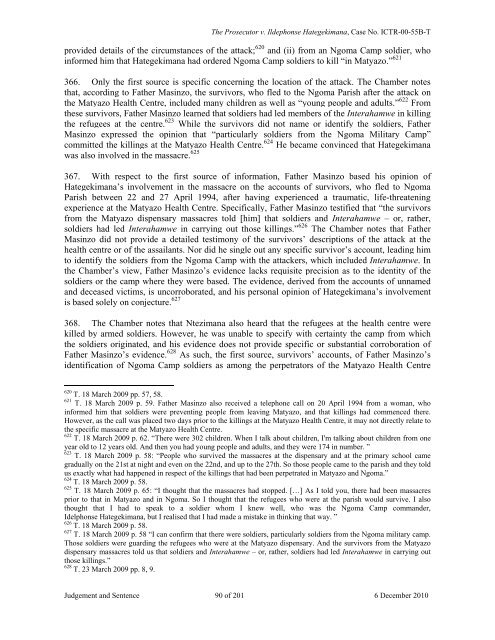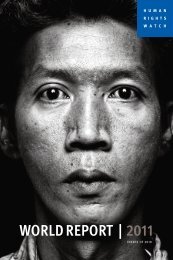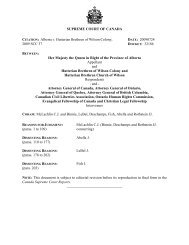Hategekimana - JUDGEMENT & SENTENCE - Refworld
Hategekimana - JUDGEMENT & SENTENCE - Refworld
Hategekimana - JUDGEMENT & SENTENCE - Refworld
Create successful ePaper yourself
Turn your PDF publications into a flip-book with our unique Google optimized e-Paper software.
The Prosecutor v. Ildephonse <strong>Hategekimana</strong>, Case No. ICTR-00-55B-T<br />
provided details of the circumstances of the attack; 620 and (ii) from an Ngoma Camp soldier, who<br />
informed him that <strong>Hategekimana</strong> had ordered Ngoma Camp soldiers to kill “in Matyazo.” 621<br />
366. Only the first source is specific concerning the location of the attack. The Chamber notes<br />
that, according to Father Masinzo, the survivors, who fled to the Ngoma Parish after the attack on<br />
the Matyazo Health Centre, included many children as well as “young people and adults.” 622 From<br />
these survivors, Father Masinzo learned that soldiers had led members of the Interahamwe in killing<br />
the refugees at the centre. 623 While the survivors did not name or identify the soldiers, Father<br />
Masinzo expressed the opinion that “particularly soldiers from the Ngoma Military Camp”<br />
committed the killings at the Matyazo Health Centre. 624 He became convinced that <strong>Hategekimana</strong><br />
was also involved in the massacre. 625<br />
367. With respect to the first source of information, Father Masinzo based his opinion of<br />
<strong>Hategekimana</strong>’s involvement in the massacre on the accounts of survivors, who fled to Ngoma<br />
Parish between 22 and 27 April 1994, after having experienced a traumatic, life-threatening<br />
experience at the Matyazo Health Centre. Specifically, Father Masinzo testified that “the survivors<br />
from the Matyazo dispensary massacres told [him] that soldiers and Interahamwe – or, rather,<br />
soldiers had led Interahamwe in carrying out those killings.” 626 The Chamber notes that Father<br />
Masinzo did not provide a detailed testimony of the survivors’ descriptions of the attack at the<br />
health centre or of the assailants. Nor did he single out any specific survivor’s account, leading him<br />
to identify the soldiers from the Ngoma Camp with the attackers, which included Interahamwe. In<br />
the Chamber’s view, Father Masinzo’s evidence lacks requisite precision as to the identity of the<br />
soldiers or the camp where they were based. The evidence, derived from the accounts of unnamed<br />
and deceased victims, is uncorroborated, and his personal opinion of <strong>Hategekimana</strong>’s involvement<br />
is based solely on conjecture. 627<br />
368. The Chamber notes that Ntezimana also heard that the refugees at the health centre were<br />
killed by armed soldiers. However, he was unable to specify with certainty the camp from which<br />
the soldiers originated, and his evidence does not provide specific or substantial corroboration of<br />
Father Masinzo’s evidence. 628 As such, the first source, survivors’ accounts, of Father Masinzo’s<br />
identification of Ngoma Camp soldiers as among the perpetrators of the Matyazo Health Centre<br />
620 T. 18 March 2009 pp. 57, 58.<br />
621 T. 18 March 2009 p. 59. Father Masinzo also received a telephone call on 20 April 1994 from a woman, who<br />
informed him that soldiers were preventing people from leaving Matyazo, and that killings had commenced there.<br />
However, as the call was placed two days prior to the killings at the Matyazo Health Centre, it may not directly relate to<br />
the specific massacre at the Matyazo Health Centre.<br />
622 T. 18 March 2009 p. 62. “There were 302 children. When I talk about children, I'm talking about children from one<br />
year old to 12 years old. And then you had young people and adults, and they were 174 in number. ”<br />
623 T. 18 March 2009 p. 58: “People who survived the massacres at the dispensary and at the primary school came<br />
gradually on the 21st at night and even on the 22nd, and up to the 27th. So those people came to the parish and they told<br />
us exactly what had happened in respect of the killings that had been perpetrated in Matyazo and Ngoma.”<br />
624 T. 18 March 2009 p. 58.<br />
625 T. 18 March 2009 p. 65: “I thought that the massacres had stopped. […] As I told you, there had been massacres<br />
prior to that in Matyazo and in Ngoma. So I thought that the refugees who were at the parish would survive. I also<br />
thought that I had to speak to a soldier whom I knew well, who was the Ngoma Camp commander,<br />
Idelphonse <strong>Hategekimana</strong>, but I realised that I had made a mistake in thinking that way. ”<br />
626 T. 18 March 2009 p. 58.<br />
627 T. 18 March 2009 p. 58 “I can confirm that there were soldiers, particularly soldiers from the Ngoma military camp.<br />
Those soldiers were guarding the refugees who were at the Matyazo dispensary. And the survivors from the Matyazo<br />
dispensary massacres told us that soldiers and Interahamwe – or, rather, soldiers had led Interahamwe in carrying out<br />
those killings.”<br />
628 T. 23 March 2009 pp. 8, 9.<br />
Judgement and Sentence 90 of 201 6 December 2010

















